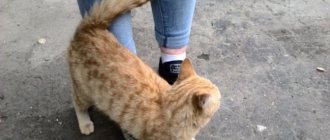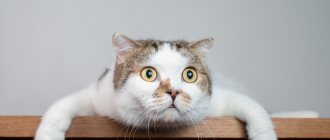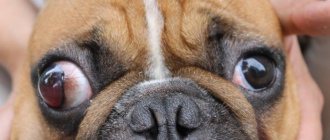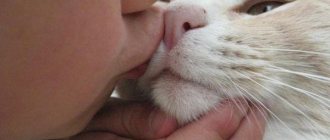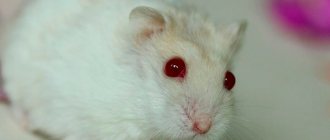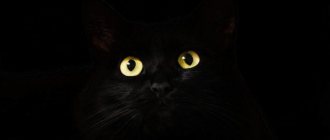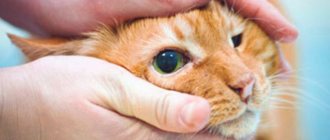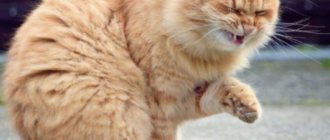It must be said right away: the eyes of cats do not actually glow in the dark, that is, they do not emit light, as many still think. They just reflect the beam that hits them. This is due to a special layer of cells in the lining of the animal's eye. It is called tapetum lucidum (lat. tapetum lucidum) and works on the principle of a mirror. Light passes through the lens and cornea and, reaching the fundus of the eye, is reflected from the tapetum.
By themselves, cat eyes will not sparkle. You can easily check this by placing your pet in a dark room without lamps or windows. It is unlikely that you will be able to see his eyes.
How does a cat's eye work?
The eyes of a cat are an amazing phenomenon. For example, the ratio of the eyeball to the entire head of an animal is 20%! This is the largest indicator of all existing ones. And also, unlike many representatives of the fauna, cats' eyes consist of three layers, each of which is responsible for its own function.
Diagram of the structure of a cat's eye.
- The retina, or retina, is the innermost layer of the eye and is responsible for color correction and overall light perception. The retina contains two types of photoreceptors:
- cones – color perception, the ability to see a clear picture, distinguish small details;
- rods – formation of vision, reception and transmission of light.
It is precisely because a cat's eye is rod-dominated that they can see with virtually no light.
Note!
The idea that cats see in complete darkness is wrong. In order for an animal to see its surroundings, at least a minimal amount of light must enter its eye.
There is a “blind spot” in the retina - an area in which there are no photoreceptors and the information falling on it is not perceived by the animal in any way.
Immediately behind this zone there is a disk that focuses all incoming light onto itself. This disc is called the “corpus luteum.”
In the very depths of a cat's eye there is a small plate that looks like liquid silver or a mirror. This plate is called tapetum.
2. Choroid - this layer provides the entire eye with important microelements, such as, for example, oxygen. In the same layer is the ciliary body, which holds the eye lens in the desired position with the help of muscles.
3. Fibrous membrane - the outer layer, which includes:
- sclera - covers almost the entire surface of the eye (3/4 of the part)
- cornea - occupies the remaining space and is responsible for receiving and transmitting light for further processing.
This shell consists of the protein elastin and collagen fibers. It protects internal processes from external influences.
Tapetum and its main function.
Unlike the human eye, a cat's eye has a tapetum, a layer of cells at the very back of the retina that reflects unabsorbed light onto the retina. It is thanks to the tapetome that cats' eyes glow.
The main function of the tapetum.
Features of vision of cats
The internal organs of a cat are identical to those of other mammals. The same cannot be said about the senses, including the eyes. They are endowed with special properties necessary for the normal functioning of a predator.
In complete darkness, an animal's vision is no different from a human's. In dim light, their orientation improves significantly. The ability to process any accessible light source is increased.
Advantage of the cat's gaze:
- large pupil and lens;
- close location of the cornea to the retina;
- roundness and contraction of the eyeball;
- extended viewing angle.
Glowing eyes Cats have the ability to accumulate light.
The mechanism is called “luminous wallpaper”. It is located behind the retina and consists of 15 spheres. The functioning of an animal's eyes is similar to the working principle of a camera. Light rays sneak through the hole, the dimensional frequencies of which are modified. The quantitative composition of light is controlled by the iris, and focused by the lens. Envelopment of the retina occurs. It sends an impulse to the brain center.
The retina is endowed with sensory cells:
- The first: is responsible for excellent vision at night and sensitivity to movement in dim flickering lamps.
- The second has resolving power.
- The slit pupil provides protection from bright flickering light.
A cat has binocular vision, just like a human. Due to the stereoscopic effect, the predator assesses the reach of prey.
glowing eyesCauses of glowing eyes.
Cats are very ancient creatures. Their history goes back to ancient Egypt and beyond. The glow of a cat's eyes caused fear among unenlightened people. And only then – interest. That is why, in addition to the scientific explanation, you can find many traditions and legends that explained this in the old days.
Scientific explanation.
The tapetum is a thin layer of cells deep in the eyeball of animals. It is also called a “mirror”, because the main function of the tapetum is to reflect light onto the retina of the eye.
It is the tapetum that explains the reasons for the glowing eyes of a cat. However, like many other animals that are nocturnal.
In this case, the glow in the cat’s eyes can be of different colors. For example, in kittens up to 3-4 months of age, the reflection has a reddish tint, because their retinal pigmentation is weak and the reflective layer is not formed. In adult cats, the color can be green or yellow - this color gives the rich luminescent pigment of the tapetum. In cats whose pigment is weaker, the eyes may glow bluish, reddish or even purple.
Another factor that affects color is the angle of light hitting the cat's eye. If the rays come from the side, you will notice that the eyes glow more blue. And if the light hits directly - yellow or green.
Interestingly, even one cat can have a different color. For example, the right eye shines yellow, and the left eye shines red. This may be due to several reasons:
- pathology or injury of one eye;
- light beam hitting at different angles;
- congenital difference in pigment saturation.
An example of different colors in one animal.
Myths and legends.
It is much more interesting to read the old beliefs that explained the glow of the eyes to the unenlightened people of past centuries.
Egypt
In ancient Egypt, the cat was considered an assistant to the lunar goddess Bastet.
Bastet protected people from the evil hiding in the dark, but since she couldn’t keep track of everyone alone, she sent people a cat. The Egyptians regarded the burning eyes of a cat as direct communication between a pet and the goddess. At such moments, it was impossible to interfere with the animal, because Bastet could punish for disrespect.
Rome
In ancient times, there lived a cruel circus owner in Rome. There were many animals in his cages and all suffered from cruelty and abuse. And only one cat managed to escape. For this, Libertas - the Roman goddess of freedom - endowed the animal with the ability to illuminate its path to freedom with the help of fire in its eyes. This is how the Romans explained the glow of a cat’s eyes, whose purring pet was an animal of freedom and will.
Japan
In the land of the rising sun, cats were the guardians of the Maneki-Neko Temple. It counted. that whoever gets the light from the cat’s eyes will be doomed to good luck and happiness.
Europe
But in medieval Europe, cats were considered familiars of witches and servants of hell. It was believed that the cat's eye burns with the flame of Satan and promises failure and misfortune.
Russia
In Orthodox Russia, cats are protectors and servants of God.
The light in the eyes is the light of the Lord himself, who created the cat as a protector of man from creatures living in darkness. These are the different myths and legends that surround the glow of a cat's eye. This phenomenon gained great popularity among people before scientists were able to understand the true causes of the biological phenomenon.
These are the different myths and legends that surround the glow of a cat's eye. This phenomenon gained great popularity among people before scientists were able to understand the true causes of the biological phenomenon.
Anatomical features of the structure of the visual organs
The outer shell of the eyeball has three layers. The first is the sclera - an elastic film responsible for the spherical shape of the apple. Next is the vascular tissue, which, through vessels and capillaries with the blood flow, supplies the outer chamber of the eye with oxygen and necessary microelements. In the same way, vessels carry away decay products in the opposite direction. The third layer is the cornea, responsible for color, in the center of which is the pupil. The function of the pupil is to focus vision on a particular object, narrowing or expanding thanks to the nerve endings.
For your information! The pupil of cats has an oval oblong shape, in bright daylight it narrows to a thin vertical slit, through which it is possible to capture a sufficient amount of information.
Structure of the organ of vision
Just behind the outer shell is the lens. The rays of light that the sclera and pupil passed through are refracted through this viscous liquid. Refracted rays are collected into beams and transmitted to the retina, which is dotted with photoreceptors in the form of bulbs and rods. Some receptors perceive images in the dark, others in light. Images from the retina are transmitted along the nerve by electrical impulses, and from there to the brain. The entire surface of the optic nerve is covered with blood vessels responsible for feeding the back of the eyeball.
How cats' eyes glow
The tapetum is a layer of flattened capillaries that is located on the back of the eyeball behind the retina. Even the smallest light waves passing through the retina are reflected from the tapetum, doubling the number of absorbed photons. This process doubles the sensitivity of vision in the dark. Simply put, the tapetum reflects light, returning it through the retina to the surface of the eye, which people perceive as a glow. But the eyes do not glow, but only reflect even the weakest light flux in an increased volume.
In a completely dark room, the cat's eyes will not glow, since they will have nothing to reflect. The color of the tapetum in cats varies from the center to the edges. At the optic nerve, the reflective layer has a delicate golden-green hue, which closer to the border becomes rich green, turning into blue-green, sometimes violet, and then a purple hue. At the very border, the tapetum becomes dark brown-red.
The eyes of other animals are endowed with a similar natural mirror: dogs, horses, rabbits, fish, crustaceans, spiders, etc. But in terms of the brightness of the glow in the dark, the cat family certainly occupies a leading place.
For your information! The human eyeball contains tapetum nigrum, which contains a minimal amount of reflective pigment. That's why human eyes don't glow in the dark. But a similar effect appears as red eyes in photographs taken with flash.
This feature of the eye structure allows cats - night hunters to see in the dark, tracking down potential prey in the form of small rodents, birds, frogs, or protecting themselves from danger, for example, from a pack of stray dogs. The cat’s pupil, which has expanded many times to the size of the iris, allows it to catch the slightest glare of light; in the daytime, it narrows to a vertical, barely noticeable line.
Dilated pupil in the dark
A cat's visual acuity is protected by the external organs of the eye. Eyelashes protect against debris and foreign bodies that can injure the eye. Blinking eyelids regularly prevent the eyeball from drying out by washing it with tear fluid from the conjunctiva. Another feature of the cat's eye is the third eyelid, or nictitating membrane. This translucent elastic film is attached to the muscles of the eyelids and is involved in moisturizing the mucous membrane. In addition, the presence of a nictitating membrane allows the cat to sleep with its eyes open without the threat of the eyeball drying out.
How to explain to children.
The owners of the furry creature and at the same time parents may notice their child’s tension in the evenings at certain times. For example, a baby absolutely does not want to let a cat into his room at night. Or he tries to avoid contact with his pet altogether. There can be many reasons and you need to deal with them immediately. And a fairly common cause is the glow of the animal’s eyes in the dark, which can frighten the baby.
Cats and children are best friends.
There are different ways to explain to children the reason for glowing cat eyes. Believing families can explain this phenomenon with a legend from their religion. For example, Christians can talk about the Lord who endowed a cat with his light so that it would drive away darkness from its owners.
If the parent does not want to mislead the child and wants to explain everything scientifically, a question arises. How can this be done so as not to break the baby’s brain, but so that he understands everything? And it turns out it's quite easy.
You can show the child a mirror and explain that in the eyes of a cat there is the same small mirror that reflects light, which is why such a phenomenon as the glow of the eyes appears.
You can show your child how it all works using a simple example. To do this, you need to take a flashlight and shine the light on the mirror. The flashing bright spot can be associated with the glowing cat's eyes, explaining to the child that the cat's eye works the same way.
Interesting information about the features of cat vision
For the most part, cats' eyes glow green or yellow. The intensity and shade are determined by the amount of zinc and riboflavin in the tapetum layer. There are also rare glow colors. For example, the eyes of Siamese cats emit red, crimson light in the dark. A decrease in the brightness of the effect comes with age. In older cats, the density of the lens increases, reducing the ability to reflect photons. The cause of dim light in young cats may be glaucoma or cataracts.
Cat eyes have several unique features:
- The visual acuity of these pets is almost 10 times higher than that of humans.
- The viewing angle of cats is 20° greater than that of humans. Our radius is 180°, for pets it is 200°.
- In terms of color perception, cat eyes are inferior to human eyes. Animals distinguish only a few shades. They see well the tones of green, black, blue, white, and gray. They do not perceive the remaining sectors of the color spectrum. It was previously believed that cats see the world in black and white, but recent research disproves this claim. There is no need to think that limited color vision causes inconvenience for cats. Pets don’t worry about the fact that they can’t distinguish between yellow and red, they don’t need it.
The quality of vision of these animals can be appreciated by two facts. A cat can see objects at a distance of half a kilometer or more. It can clearly see the smallest details of an object at a distance of 60 meters. The most vigilant person does not have such qualities.
There are some differences in the perception of static and moving objects. Animals can better see an object that is moving. Moreover, they see objects moving horizontally most clearly. The cat sees vertically moving objects worse.
It is known that dogs see nearby objects better, but their vigilance decreases when they move away. Cats' vision organs are structured differently. These pets are myopic. They have difficulty seeing objects located nearby, but are excellent at viewing distant targets.
Lack of light in the cat's eyes.
Eyes that do not reflect light
In healthy cats and kittens, the tapetum always reflects incoming light rays onto the retina, which is why the cat's eyes glow in twilight and partial darkness. This is normal and one of the basic biological processes characteristic of animals that are nocturnal. If at least some part of a pet’s eye does not function, this is a reason for the owner to think and tense up.
The absence of glow indicates problems with luminescent pigmentation of the eyeball and a lack of taurine sulfonic acid and other amino acids. This is caused by various injuries and diseases.
Taurine is a sulfonic acid that is responsible for many processes in the body. Unlike other animals, cats cannot produce this acid on their own and only get it from animal foods.
That is why owners should monitor their pet’s health and nutrition. And this is precisely what answers the question of why pets need a balanced diet.
An example of the partial absence of luminescent pigment.
Excursion into history
In European states, starting from the fourteenth century, all representatives of the cat family were considered servants of the devil and the first companions of witches. These superstitions appeared precisely because people could not answer the questions: why do a cat’s eyes glow in the dark , their pupils are vertical, and why is she too independent and independent? Black cats were especially persecuted; they were probably not loved because of how quickly they could hide in the dark. Enraged fanatics burned beautiful girls along with cats, thus depleting the gene pool of both in those dark times.
Did you know? In more ancient times, cats were considered protectors, excellent hunters and even deities. In many countries they were indeed considered special; according to pagan beliefs, these animals were messengers of the god Rod, those who were sent to observe life on earth and then convey the information received to the gods. Legends that have survived to this day say that Makosh, the goddess of water, revered by the ancient Slavs, asked the god Rod for someone who could look after people. Rod thought about it, and then created a mustachioed creature that moves between the boundaries of reality and warns the human race about approaching disasters. He gave one cat to each of the gods, and sent several down to multiply and keep human homes.
Is it a pathology?
The absence of light reflection in the eyeball clearly indicates pathology and health problems of the animal. Most often, such problems affect elderly and old cats - the lens of the eye thickens and begins to reflect less light.
Problems may also indicate a serious cat disease such as cataracts or glaucoma. Or for injuries that can be received by a pet under various circumstances - from an accident at home, ending with the outcome of a fight between another cat or dogs.
The pathology of lack of light reflection can accompany a kitten from its very birth. There is no way to influence this process without surgical intervention. Why might this happen? Due to improper formation of fetal organs in the womb. However, in this situation, the kittens live and grow up safely, and there is no risk of death. But it can lead to problems with other body processes.
How to treat.
Attention!
If you suspect a health problem with your pet, you should immediately contact a veterinary clinic or veterinarian! Under no circumstances should you self-medicate an animal!
Only a veterinarian can tell you how to treat pathologies of a cat’s eyeball. It is better not to self-medicate, as well as look for medications and help on the Internet.
But you can protect your pet from diseases. There are many different ways to do this that are available to any responsible owner.
Cats and vitamins.
- If your cat has access to the outdoors, you should be more attentive to its surroundings and monitor the animal, trying to prevent fights or attacks by larger animals.
- It is necessary to ensure that the animal gets taurine. The pet products market offers a sufficient amount of food that already contains the necessary amino acids. Even more essential substances can be found in vitamins and dietary supplements for animals.
- If your animal is fed at home, you should always ensure that the diet includes foods containing taurine. Such products include chicken, fish, beef, turkey, cheese, dairy and fermented milk products.
- Timely consultations and preventive examinations with a veterinarian are the key to the health of the pet and the peace of mind of the owner.
If your cat has eye health problems, don’t panic right away. Thanks to numerous clinics and accessible veterinary medicine, you can take the problem into your own hands and quickly help your beloved animal without consequences or serious intervention.
Healthy cat.

